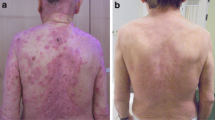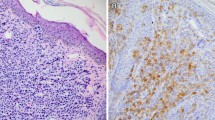Abstract
Purpose/objective(s)
We report our experience with single-fraction radiation therapy in treating limited extent CTCL lesions for palliation.
Materials/methods
We reviewed 65 lesions in 18 patients with stage IA–IIB CTCL treated with a single fraction at our institution from December 2014 to April 2016. Fifteen patients had mycosis fungoides; all others (three) had primary cutaneous anaplastic large cell lymphoma. Clinical response to treatment was defined as complete response (CR, 90–100% reduction), partial response (PR, >50% but <90%), and no response (NR).
Results
All lesions were treated to a dose of 8 Gy, with a mean follow-up for all patients of 9 months (range 1–21 months). There was a CR in 61 (93.8%) lesions. Three lesions (3.8%) had an initial PR and one (1.5%) had NR; all were re-treated to a dose of 8 Gy in 1 fraction. Three of these lesions went on to have a CR. Lesions that had a PR/NR were large (>14 cm) and involved the anterior thigh, posterior thigh, left buttock, and posterior neck. Tumor stage lesions responded equally well as plaque or patch lesions. Twelve of these lesions in three patients were those that were persistent after total skin electron therapy (TSET) to a dose of 36 Gy in 24 fractions. These lesions were in areas of skin folds and were treated 6–8 weeks after completion of TSET. CR was achieved in all these residual lesions with an additional single-fraction dose of 8 Gy. No treatment-related toxicity was observed in any of the patients.
Conclusion
Single-fraction radiation therapy is a highly effective palliative approach for treating limited extent CTCL lesions with minimal toxicity.

Similar content being viewed by others
References
Weinstock MA, Reynes JF (1999) The changing survival of patients with mycosis fungoides: a population-based assessment of trends in the United States. Cancer 85(1):208–212
Korgavkar K, Xiong M, Weinstock M (2013) Changing incidence trends of cutaneous T-cell lymphoma. JAMA Dermatol 149(11):1295–1299
Pimpinelli N et al (2005) Defining early mycosis fungoides. J Am Acad Dermatol 53(6):1053–1063
Olsen E et al (2007) Revisions to the staging and classification of mycosis fungoides and Sezary syndrome: a proposal of the International Society for Cutaneous Lymphomas (ISCL) and the cutaneous lymphoma task force of the European Organization of Research and Treatment of Cancer (EORTC). Blood 110(6):1713–1722
Kaye FJ et al (1989) A randomized trial comparing combination electron-beam radiation and chemotherapy with topical therapy in the initial treatment of mycosis fungoides. N Engl J Med 321(26):1784–1790
Elsayad K et al (2015) Total skin electron beam for primary cutaneous T-cell lymphoma. Int J Radiat Oncol Biol Phys 93(5):1077–1086
Piccinno R, Caccialanza M, Percivalle S (2009) Minimal stage IA mycosis fungoides. Results of radiotherapy in 15 patients. J Dermatolog Treat 20(3):165–168
Wilson LD, Kacinski BM, Jones GW (1998) Local superficial radiotherapy in the management of minimal stage IA cutaneous T-cell lymphoma (mycosis fungoides). Int J Radiat Oncol Biol Phys 40(1):109–115
Micaily B et al (1998) Radiotherapy for unilesional mycosis fungoides. Int J Radiat Oncol Biol Phys 42(2):361–364
Thomas TO et al (2013) Outcome of patients treated with a single-fraction dose of palliative radiation for cutaneous T-cell lymphoma. Int J of Radiat Oncol* Biol* Phys 85(3):747–753
Specht L et al (2015) Modern radiation therapy for primary cutaneous lymphomas: field and dose guidelines from the International Lymphoma Radiation Oncology Group. Int J Radiat Oncol Biol Phys 92(1):32–39
Cotter GW et al (1983) Palliative radiation treatment of cutaneous mycosis fungoides—a dose response. Int J Radiat Oncol Biol Phys 9(10):1477–1480
Goddard AL et al (2015) Palliative therapy for recalcitrant cutaneous T-cell lymphoma of the hands and feet with low-dose, high dose-rate brachytherapy. JAMA Dermatol 151(12):1354–1357
Olsen EA et al (2011) Clinical end points and response criteria in mycosis fungoides and Sezary syndrome: a consensus statement of the International Society for Cutaneous Lymphomas, the United States cutaneous lymphoma consortium, and the cutaneous lymphoma task force of the European Organisation for Research and Treatment of Cancer. J Clin Oncol 29(18):2598–2607
Acknowledgements
We would like to thank Stephanie Stebens, MLIS, and Sarah Whitehouse, MAW, for their kind review and help with preparation of this manuscript.
Author information
Authors and Affiliations
Corresponding author
Ethics declarations
Funding
No funding was received for this study.
Conflicts of interest
The authors declare that they have no conflict of interest.
Ethical approval
All procedures performed in studies involving human participants were in accordance with the ethical standards of the institutional and/or national research committee and with the 1964 Helsinki declaration and its later amendments or comparable ethical standards.
Informed consent
For this type of study, formal consent is not required.
Rights and permissions
About this article
Cite this article
Modh, A., McHargue, C.A., Lim, H.W. et al. Single-fraction radiation therapy provides highly effective palliation for cutaneous T cell lymphoma. J Radiat Oncol 6, 301–305 (2017). https://doi.org/10.1007/s13566-017-0308-5
Received:
Accepted:
Published:
Issue Date:
DOI: https://doi.org/10.1007/s13566-017-0308-5




